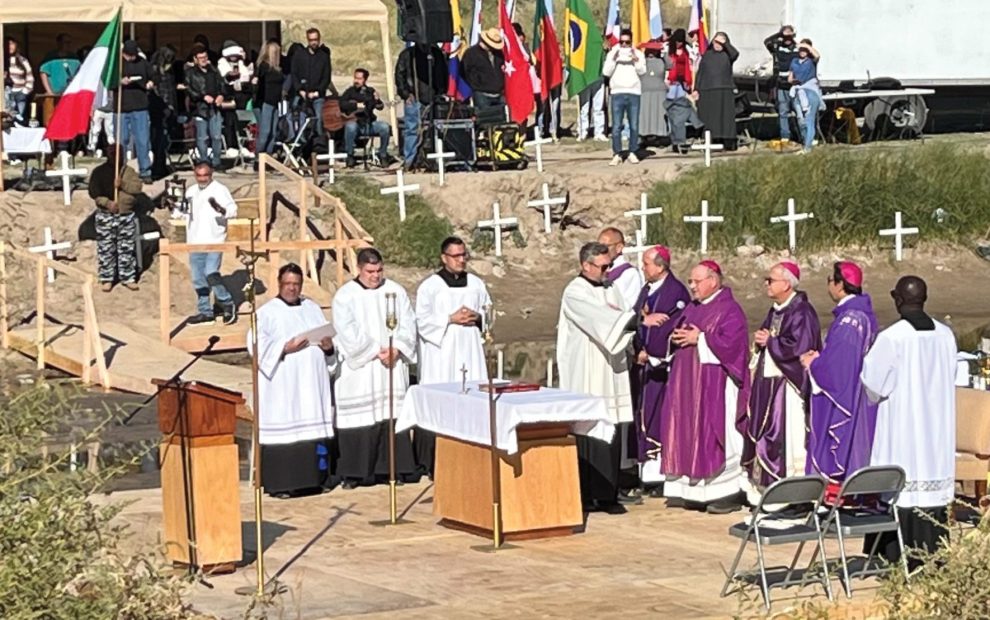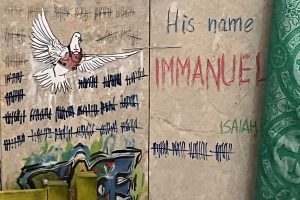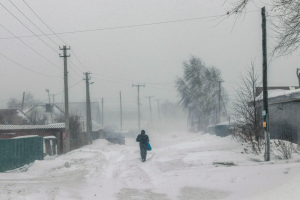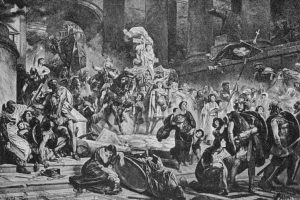White wooden crosses reflected upside down in standing pools of water were planted on the southern bank of the Rio Grande. Bishops from El Paso, Texas; Las Cruces, New Mexico; and Ciudad Juarez, Mexico were on hand to celebrate the 2023 Binational Border Mass in a dammed-up portion of the Rio. The chancel, a plywood square measuring about 30 by 30 feet, sat in the middle of the riverbed, astride the border if you could see it. Flags of Central and South American countries fluttered on the Mexican side, bright against the scrub and dust of the Franklin Mountains, and rust-colored metal beams of the border wall ran up the mountains and disappeared into the passes.
The weather this early November Saturday was bright and clear with west Texas sun. On the American side of the Rio Grande were Franciscan friars in brown habits, religious sisters in street clothes, and a large group of Catholic high schoolers who had bused all the way down from St. Louis. Conversations commingled in Spanish and English. There was a single Border Patrol officer, whose expression behind reflective sunglasses suggested a practiced neutrality.
Each cross represented a life lost during the past year in this sector of the U.S.-Mexico border, taken by the unexpected menace of the Rio’s undertow, the heat of the Chihuahuan desert, the callousness of cartels, or coyotes. The sun was unrelenting and astringent, casting fire upon earth stubbled with rock, cactus, and burrs so sharp they stabbed through bike tires and dogs’ paws. The past summer, the weather had been feverish, reading 100 or above for more than 40 days in a row. It was a harsh landscape, but folks here have the reputation of being some of the friendliest in the country.
The Mass was held only a few weeks after the first universal session of the Synod on Synodality concluded, a gathering of the global church to discern “communion, participation, and mission.” The Mass fit into the synod’s initiative of learning to “walk together” as a church (the pope has singled out El Paso Bishop Mark Seitz for his pastoral work there).
When the Holy Spirit descended upon the apostles at Pentecost and inspired them to speak, their listeners asked in astonishment, “How is it that we hear, each of us, in our own native languages?” (Acts 2:7). At the Mass, the liturgy married the polylingual character of Pentecost and the borderland: The choir alternated not only between languages but also between nations, as Spanish guitars sounded from both sides of the river. Bishop Peter Baldacchino of Las Cruces, New Mexico—himself an immigrant from the Mediterranean island of Malta—gave his homily in Spanish and English. From the legacy of Babel’s ashes the Holy Spirit emerged as tongues of flame. Through Pentecost, a novel type of community, worship, and language were born. But what was Pentecost in the borderland with its white crosses and Border Patrol? For those slogging through Panamanian jungles and Mexican migrant camps, ending up as an anonymous white cross in the November sunlight of west Texas, what claim could they make of the Holy Spirit, “Lord and Giver of Life”?
There were no easy answers, theologically or politically, and any answer would be a messy one. The Mass was a practical experiment in what Augustine and Aquinas taught: To love is to know, and knowledge is best gained through the messiness of flesh-and-blood experience. By welcoming the stranger, we at some level have to abandon ourselves to an encounter whose end result we cannot fully anticipate, something we humans are notoriously bad at.
But doesn’t the Bible witness to exactly these sorts of encounters as the dwelling place of the Lord? When against this mystery of God, we opt for material and psychological security, not only do we close ourselves off to that mystery; we also drift into fortress mentalities of bolted doors, barred windows, and militarized borders—idolatry under the apologetics of patriotism and national sovereignty.
At the border, an older woman held a rainbow placard proclaiming in caps, “WE ARE ALL IMMIGRANTS.” As I’ve discovered, to my naïve surprise, many on the American side disagreed. The borderland is a place of doubles and contradictions. Anapra looks from the border wall up toward the manicured campus of University of Texas at El Paso. Locals pride themselves on El Paso’s reputation for safety, but most refuse to cross the border, scared off by Juarez’s history of cartel turf wars and collateral violence. My guess is that most Americans who advocate for stronger border security, consciously or unconsciously associate migrants with this danger, as if each person crossing from Juarez has been infected by vice and violence, coming to contaminate U.S. neighborhoods and imperil a certain image of America.
A similar mindset runs through current Catholicism, as different parties try to diagnose the pathologies afflicting the church. As one former bishop has claimed, no doubt speaking for a wide swath of American Catholics, Pope Francis’ theological vagueness has resulted in “making a mess” within the church, downplaying urgent questions of “who and what a human being is.” What we are losing, this critique and others imply, is the metaphysical language that used to be taken for granted in Catholic discourse. For the ambiguity of “accompaniment” and “synodality,” so the reasoning goes, the Francis papacy has sacrificed doctrinal precision and pastoral authority. Catholics no longer know what a person is, and there is no one willing or able to tell them.
To what extent, however, can metaphysical language or doctrinal precision fully encapsulate the mystery of God? If that were possible, why have many of the church’s greatest saints turned to poetry and allegory to express the paradoxes of faith?
If Pope Francis has made a “mess of things” as certain critics suggest, perhaps it has been a prelude, a necessary tension in the process of releasing the church from the cultural and ecclesial dichotomies that have come to plague American Catholicism. The synod, it seems, is about the weirdness of walking together, whether as a global church or as a borderland community, especially when identities are threatened and the common good calls for us to sacrifice our deeply held resources or ideologies. Pope Francis asks the church in Fratelli Tutti (On Fraternity and Social Friendship), to “dream, then, as a single human family, as fellow travelers sharing the same flesh, as children of the same earth.” If it seems irresponsibly childish to dream in a world afflicted by war and want, that is probably the point; before they are catechized into a world of winning and losing, children play, make believe, and dream together as naturally as they sleep. On both sides of the Rio Grande, we were trying to remember ourselves a single human family beloved by God.
As Mass drew to a close, I wondered how long those white crosses would stay there. Looking across the river, I thought I saw a pair of children’s tennis shoes laced over the arm of a cross. What duty do the living have to the dreams of the dead, especially the dead of whom we know so little, lives so distant from ours, strangers really? It was dangerous to dream, as the crosses showed. My faith felt thin and pale, like gauze in the sunlight. I imagined the sneakers as white with pink stripes, once belonging to a girl who held someone’s hand through dark jungles, enduring the stares of strange men and the gnaw of hunger. She died for a dream. Who among us has been willing to risk so much, to walk by such naked faith toward a life sustained only in dreams? Do we ourselves dream anymore, or have we let the politicians, scientists, and marketing departments do it for us?
Right after Pentecost, Peter preached, quoting the prophet Joel, that on the “Day of the Lord,” the young will see visions and the old will dream dreams. We can at least claim this: When we dream beyond ourselves, toward something good and true and beautiful, the Holy Spirit walks with us. Walking away from the border, I took comfort in this, that the men and women and children represented by those crosses had the Holy Spirit with them to the end, and beyond, toward the face of God’s mercy.
This article also appears in the July 2024 issue of U.S. Catholic (Vol. 89, No. 7, pages 25-26). Click here to subscribe to the magazine.
Image: Evan Bednarz












Add comment